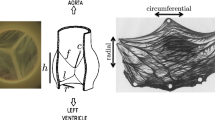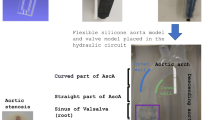Abstract
The aortic valve consists of three thin (0.1 mm) cusps and three matching sinuses. The cusps are reinforced with collagen strands running from commissure to commissure. Under no load the cusps furl up in the axial direction. When closed, the cusps are stretched out and are supported by the underslung loops of collagen. A photograph of a human aortic root is shown in Figure 1 of chapter 6.1. The left ventricle is marked V the aorta A, a cusp C and its corresponding sinus S. The diameter of the aorta is approximately 25 mm. In measurements of instantaneous velocity in the ascending aortas of dogs, using heated thin-film gauges (1), it was shown that aortic blood-flow was laminar, that there was no central jet and that reversed flow at the end of systole was very small. These measurements showed, however, that velocity was not uniform across the aorta. These results were surprising, because they implied that the valve was open wide at mid-systole, otherwise the flow would have been turbulent (since the peak Reynolds number was 10,000), but that the valve closed, or nearly closed, during systole with flow still going forwards through the valve. Since the thin-film gauge responds to velocity fluctuations of frequencies well in excess of 10kHz, turbulence would certainly have been detected had it existed.
Access this chapter
Tax calculation will be finalised at checkout
Purchases are for personal use only
Preview
Unable to display preview. Download preview PDF.
Similar content being viewed by others
References
Schultz DL, Tunstall-Pedoe DS, Lee G de J, Gunning AJ, Bellhouse BJ: Velocity distribution and transition in the arterial system. In: CIBA foundation symposium on circulatory and respiratory mass transport, London, 1968, p 172.
Vinci L da: Quaderni d’Anatomica 2:9, 1513.
Henderson Y, Johnson FE: Two modes of closure of the heart valves. Heart 4:69–82, 1912.
Bellhouse BJ, Bellhouse FH: Fluid mechanics of model normal and stenosed aortic valves. Circ Res 25:693–704, 1969.
Bellhouse BJ, Bellhouse FH: Thin-film gauges for the measurement of velocity or skin friction in air, water or blood. J Sci Instr 1 (series 2): 1211, 1968.
Editor information
Editors and Affiliations
Rights and permissions
Copyright information
© 1980 Martinus Nijhoff Publishers bv, The Hague, Boston, London
About this chapter
Cite this chapter
Bellhouse, B.J. (1980). Fluid Mechanics of the Aortic Valve. In: Baan, J., Arntzenius, A.C., Yellin, E.L. (eds) Cardiac Dynamics. Developments in Cardiovascular Medicine, vol 2. Springer, Dordrecht. https://doi.org/10.1007/978-94-009-8796-8_45
Download citation
DOI: https://doi.org/10.1007/978-94-009-8796-8_45
Publisher Name: Springer, Dordrecht
Print ISBN: 978-94-009-8798-2
Online ISBN: 978-94-009-8796-8
eBook Packages: Springer Book Archive




